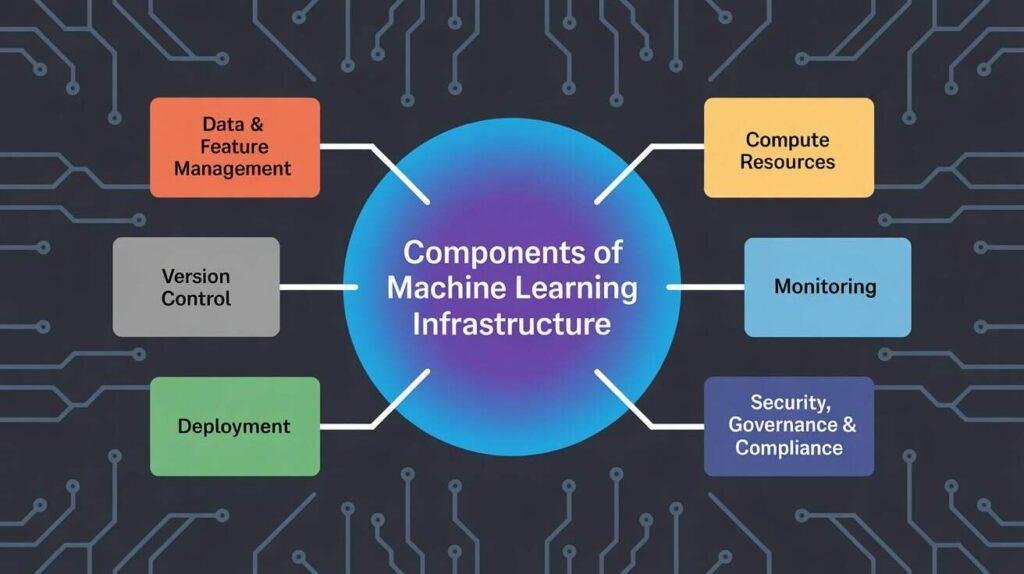In the moment’s digital frugality, infrastructure for machine learning plays a central part in driving invention across intelligence. Organizations worldwide are redefining how to implement systems, manage resources, and ensure scalability for ultramodern workloads. As artificial intelligence continues to form, the demand for proficient professionals and effective fabrics continues to grow steadily. Also, businesses no longer see machine learning as experimental exploration. Rather, it has now become critical for competitive advantage. Companies depend on machine learning to reuse data, automate operations, and deliver insight quickly. To meet these rising requirements, the conception of erecting a strong infrastructure has become more important than ever before.
Why Infrastructure for Machine Learning Matters?
Every successful AI design requires a strong, specialized foundation and dependable systems. Without an effective infrastructure for machine learning, indeed, the most advanced algorithms fail to perform consistently. Systems must be able to manage large datasets, handle distributed workloads, and conduct rapid-fire trials across multiple brigades. In addition, associations must balance both cost and effectiveness while planning AI systems. With growing demand for predictive analytics, enterprises need dependable systems that simplify operations. Thus, optimized machine learning infra is now a top priority for enterprises that want to introduce while staying cost-effective. For illustration, healthcare companies use these systems to diagnose conditions beforehand. At the same time, fiscal enterprises rely on an online learning structure for fraud prevention. Across every sector, structure ensures AI delivers value rather than remaining a promising idea.
Role of the Machine Learning Infrastructure Engineer
Behind every important AI system stands a machine learning infrastructure engineer who builds and maintains the specialized terrain. These professionals design fabrics that support advanced models while managing computing, storage, and networking costs effectively. Likewise, masterminds ensure systems remain dependable indeed under heavy workloads. They also team with data scientists to align structure with exploration retentions. In addition, they cover performance, apply obfuscation, and secure sensitive datasets from itfalls. Because of this wide responsibility, the ML structure term is now considered one of the most crucial places in the technology geography. For illustration, e-commerce titans employ similar asterminds to gauge recommendation systems during seasonal business surges. Also, logistics companies depend on them to optimize routing results.
Training the Next Generation: Courses and Education
To bridge the global IT gap, numerous institutions now offer a machine learning infrastructure course. These programs educate practical chops in managing all platforms, erecting channels, and planting models in production. Scholars also learn to work with GPU clusters, containerization, and unity systems. Inversely important, learners gain hands-on experience with tools like Kubernetes, Docker, and TensorFlow serving. By completing a machine learning infrastructure course, scholars place themselves as ready-made masterminds able to support large-scale AI Adoption. As a result, industries can depend on a stronger, well-set pool. Professional training ensures that coming machine learning infrastructure experts develop a strong hand of both theoretical foundations and practical operations. This combination of chops helps companies maintain long-term success.
Core Components of Machine Learning Infrastructure
The term machine learning infra refers to the full specialized infrastructure needed to support artificial intelligence operations. ML infrastructure is the foundation that supports the whole machine learning lifecycle. Following are the key components:
- Data & Feature Management – includes data ingestion, storage( lakes/warehouses), preprocessing, versioning, and feature stores.
- Compute Resources – CPUs, GPUs, TPUs, and clusters for training and inference, with scaling and scheduling support.
- Experimentation & Version Control – tracking experiments, models, datasets, and hyperparameters to ensure reproducibility.
- Deployment & Serving – deploying models as APIs, batch jobs or edge services, with containerization and rollbacks.
- Monitoring– tracing precision, latency, drift, logging, and warning in production.
- Security, Governance & Compliance – access control, encryption, audit trails, bias checks, and nonsupervisory compliance.

Together, these factors allow companies to make, deploy, cover, and scale ML models reliably.
Challenges in Building Infrastructure for ML
Although progress has been rapid, several challenges remain for businesses. Spanning structure is expensive and requires nonstop upgrades in both tackle and cloud services. Companies must balance energy usage, storage capacity, and latency requirements while avoiding unnecessary costs. Moreover, skilled professionals in this field remain limited. Numerous associations struggle to hire good ML infrastructure engineers able to manage complex systems.
Indeed, with a clear strategy, prosecution frequently requires times of technical moxie. Another issue involves keeping systems adaptive and flexible. With AI technologies evolving rapidly, enterprises must avoid erecting rigid surroundings. Rather, adaptive machine literacy infra ensures that stationed models stay applicable over the long term. Thus, leaders must prioritize flexible design over short-term effectiveness alone.
Opportunities for Businesses
Despite these challenges, opportunities continue to grow for forward-looking associations. Companies that invest in machine learning infrastructure gain a clear competitive advantage. They deliver services briskly, make further accurate predictions, and reduce both functional risks and costs. Likewise, robust architecture supports operations across multiple diligence. For illustration, hospitals enhance patient care through predictive models, while financial institutions enhance security with real-time fraud detection.
So, by strengthening the machine learning infrastructure, associations unlock the full capability of their data means. In addition, strategic investments attract talented professionals, as experts prefer working in environments with modern frameworks and scalable systems. Ultimately, advancing machine learning infrastructure helps businesses secure top talent while also boosting overall efficiency.
Road Ahead
Looking ahead, the future of AI systems appears both negative and promising. Cloud providers now offer advanced results optimized specifically for AI workloads, making machine learning infrastructure more accessible for startups and small businesses worldwide. At the same time, educational programs continue to expand. With each new machine learning infrastructure course, participants are better prepared to contribute meaningfully to the field. This expansion helps eliminate the skill gap and accelerate AI adoption across different quests. In addition, the part of the ML infrastructure, ermind, will continue to evolve. As automation grows, engineers will move from doing manual work to creating new solutions. Their skills will focus more on creativity, flexibility, and making a strategic difference.
To conclude, the infrastructure for machine learning represents the backbone of ultramodern artificial intelligence. Without strong systems, businesses can not gauge or sustain advanced results. The rise of technical places similar to the machine learning infrastructure engineer reflects growing global requirements for specialized, accessible training options, like a machine learning infrastructure course, that prepare new professionals for long-term success. As associations read their ML infrastructure, they gain effectiveness, adaptability, and lead innovation. Eventually, we sign a contract that ensures AI continues to substantiate diligence and perceive lives worldwide. Also, businesses invest in the mental will’s intelligent frugality.

